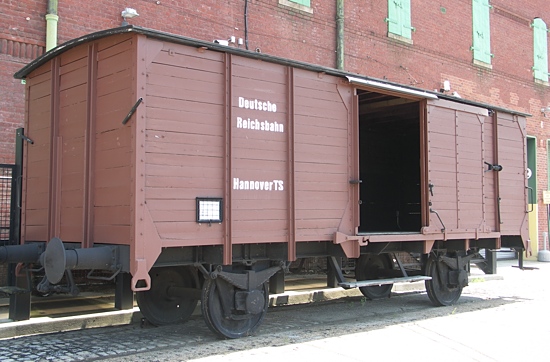Holocaust Museums’s Nazi boxcar an Endangered Artifact nominee
Found by a local Holocaust survivor, the boxcar used by the Nazis is among Virginia’s most needful historical items.

A boxcar Nazis likely used as they herded millions to their death is one of many historical objects vying to be named an endangered artifact.
The Virginia Association of Museums recently launched the Top 10 Endangered Artifacts initiative to highlight threatened artifacts, as well as the conservation concerns daunting the Virginia museums and cultural centers that care for them.
“The top ten are actually voted on by conservators and collection specialists, and they decide which artifacts are the most endangered,” said Megan Ramsey, Assistant Curator at the Virginia Holocaust Museum, owners of the historic boxcar, about the Top 10 Endangered Artifacts initiative.
While experts will ultimately decide the state’s ten most imperiled items, an online public vote will determine a “people’s choice” honoree. Voting ends on August 23rd.
“There’s no money that comes out of it,” Ramsey said about those artifacts ranked among the 11 total nominees. “It’s just a way to kind of raise public awareness of collections care.”
However, should the Virginia Holocaust Museum (VHM) one day apply for grant money to conserve the boxcar, being among the honorees would show “that both the public and collection specialists understand how endangered it is and how important it is” and help earn the VHM the money it needs to care for it, Ramsey said.
The museum took possession of the authentic Deutsche Reichsbahn “goods” wagon in 2003, one year after the museum moved into an old tobacco warehouse at 2000 E. Cary Street. “It was through the efforts of a local Holocaust survivor that helped get the boxcar here,” Ramsey said.
Nazis shipped German-born Alexander Lebenstein to several labor camps after they killed his mother and father when Lebenstein was a young man. Russian forces eventually liberated him from the Stutthof camp in 1945. Lebenstein made his home in Richmond,1 regularly speaking at the VHM and other venues.
Shortly after the VHM relocated to E. Cary Street, he learned the museum wanted a boxcar to display. During a trip to Germany, Lebenstein helped procure the roughly 26’ x 9.5’ x 7’ Deutsche Reichsbahn boxcar, which the VHM debuted in 2003.2
“It’s my favorite artifact and it’s what a lot of people think of when they think of the museum. It’s outside and the whole public can see it,” Ramsey said. “You can actually walk into the boxcar, which is a pretty unique experience.”
Although the museum has no “concrete evidence” that the boxcar was used to transport victims, “we know that the Nazis used it in the 1930s and 1940s,” Ramsey said, and that similar boxcars (if not the one outside the VHM) held between 100 and 120 people during each trip.
Its installation outside the museum exposes the boxcar to the public and also exposes it to Mother Nature. “So it’s always in whatever weather is happening. There is no type of enclosure, or even covering for it. So it’s out in the elements,” Ramsey said. “We’ve had to constantly replace a lot of the boards because of the rain coming in, it just deteriorates and rots the wood,” Ramsey said. “About every two years we have to replace three or four boards.”
So why not bring it indoors?
“That would be the ideal situation. The problem with that is its size,” Ramsey said. “We would have to rip out floors and basically redesign a lot of the building in order for it to fit inside, which is a huge undertaking and costs much too much money than we currently have.” Had the museum acquired the boxcar before moving into their current space, perhaps the museum’s interior could’ve been designed to accommodate it.
Ramsey and other VHM officials hope the Endangered Artifacts program will help draw attention to the museum’s need to care for it, and may even lead to donations or an eventual grant to secure its conservation.
“It’s an important artifact that we want to show that we actually care for it,” Ramsey said. “And that we need help in caring for it.”
You may vote for the boxcar online. Voting ends on August 23rd. The top 10 honorees and the “people’s choice” will be announced on September 9th.
Photo courtesy of the Virginia Holocaust Museum
- He died here in 2010 at the age of 82. ↩
- Here are photos of the boxcar’s voyage from Germany. ↩
-
Recommend this
on Facebook -

Report an error
-

Subscribe to our
Weekly Digest





There is 1 reader comment. Read it.